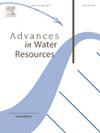相干涉在多孔介质稳态两相流中的作用
IF 4.2
2区 环境科学与生态学
Q1 WATER RESOURCES
引用次数: 0
摘要
当两种流体在多孔介质中以低流速同时流动时,称为稳态两相流,总压降与达西通量偏离线性关系。这种偏差主要是由孔喉处相间干涉引起的毛细管压降引起的。本研究旨在基于流体-流体界面面积估算孔隙尺度下的毛细压降。认识到稳态两相流通常表现出不连续的行为,我们提出了一个简单的方程来解释总压降、粘性压降和毛细压降之间的关系。在透明微模型上进行了实验,研究了排吸两种条件下流速、平均粘度和孔隙结构的影响。结果表明,毛细管压降与流动润湿相和流动非润湿相的比界面面积呈线性关系。此外,毛细管压降比界面面积曲线的斜率仅与流量有关。建立并验证了比界面面积与相对渗透率之间的关系。该研究为两相流中达西通量与压降的非线性关系提供了新的认识。本文章由计算机程序翻译,如有差异,请以英文原文为准。
The role of phase interference in steady-state two-phase flow in porous media
When two fluids flow simultaneously in a porous medium at a low flow rate, known as steady-state two-phase flow, the total pressure drop deviates from a linear relationship with the Darcy flux. This deviation is primarily caused by the capillary pressure drop induced by interphase interference at pore throats. This study aims to estimate the capillary pressure drop based on fluid–fluid interfacial area at the pore scale. Recognizing that steady-state two phase flow typically exhibits discontinuous behavior, we proposed a simple equation to explain the relationship between total pressure drop, viscous pressure drop, and capillary pressure drop. Experiments were conducted in transparent micromodels to investigate the effects of flow rate, average viscosity and pore structure under both drainage and imbibition conditions. The results indicate a linear relationship between capillary pressure drop and the specific interfacial area of the moving wetting and moving non-wetting phase. Additionally, the slope of the capillary pressure drop-specific interfacial area curve is only related to the flow rate. Moreover, we established and verified the relationship between the specific interfacial area and relative permeability. This study provides new insights into the nonlinear relationship between Darcy flux and pressure drop in two-phase flow.
求助全文
通过发布文献求助,成功后即可免费获取论文全文。
去求助
来源期刊

Advances in Water Resources
环境科学-水资源
CiteScore
9.40
自引率
6.40%
发文量
171
审稿时长
36 days
期刊介绍:
Advances in Water Resources provides a forum for the presentation of fundamental scientific advances in the understanding of water resources systems. The scope of Advances in Water Resources includes any combination of theoretical, computational, and experimental approaches used to advance fundamental understanding of surface or subsurface water resources systems or the interaction of these systems with the atmosphere, geosphere, biosphere, and human societies. Manuscripts involving case studies that do not attempt to reach broader conclusions, research on engineering design, applied hydraulics, or water quality and treatment, as well as applications of existing knowledge that do not advance fundamental understanding of hydrological processes, are not appropriate for Advances in Water Resources.
Examples of appropriate topical areas that will be considered include the following:
• Surface and subsurface hydrology
• Hydrometeorology
• Environmental fluid dynamics
• Ecohydrology and ecohydrodynamics
• Multiphase transport phenomena in porous media
• Fluid flow and species transport and reaction processes
 求助内容:
求助内容: 应助结果提醒方式:
应助结果提醒方式:


